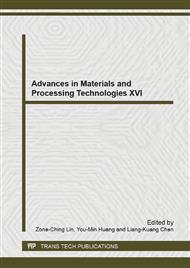[1]
J. C. Huang, Y. J. Weng, S.Y. Yang, Y. C. Weng, and J. Y. Wang, Fabricating Nanostructure by Atomic Force Microscopy, Jpn. J. Appl. Phys. 48 (2009) 095001-1-095001-5.
DOI: 10.1143/jjap.48.095001
Google Scholar
[2]
J. C. Huang, Y. -J. Weng and J. W. Lee, Evaluation of the Nanofabrication and Corrosion on Copper by In-situ ECAFM, Journal of Chinese Society of Mechanical Engineers 32 (2011) 61-66.
Google Scholar
[3]
Ching-Been Yang, Hsiu-Lu Chiang, Jen–Ching Huang, Study on Advanced Nano-Scale Near field photolithography, Scanning 32 (2010) 351-360.
DOI: 10.1002/sca.20204
Google Scholar
[4]
J. C. Huang, Fabricating nanostructures through a combination of nano-oxidation and wet etching on the different surface conditions of silicon wafer, Scanning 34 (2012) 264-270.
DOI: 10.1002/sca.21004
Google Scholar
[5]
J. C. Huang, J. W. Lee, C. L. Li, Nano-scratching and nano-machining in different environments on Cr2N/Cu multilayer thin films", Thin Solid Films 519 (2011) 4992-4996.
DOI: 10.1016/j.tsf.2011.01.067
Google Scholar
[6]
Jen-Ching Huang, Jui-Yang Wang, The Fabrication and Preservation of Nanostructures on Silicon Wafers with a Native Oxide Layer, Scanning 34 (2012) 347-356.
DOI: 10.1002/sca.21007
Google Scholar
[7]
Jen-Ching Huang, Chin-Lin Tsai and Ampere A. Tseng, The influence of the bias type, doping condition and pattern geometry on AFM tip-induced local oxidation, Journal of the Chinese Institute of Engineers 33 (201) 55-61.
DOI: 10.1080/02533839.2010.9671596
Google Scholar
[8]
A. A. Tseng, J. I. Shirakashi, S.K. Jou, J. C. Huang, and T. P. Chen, Scratch properties of nickel thin films using atomic force microscopy, J. Vac. Sci. Technol. B 28 (2010) 202-210.
DOI: 10.1116/1.3292944
Google Scholar
[9]
J. C. Huang, Chia-Lin Li, Jyh-Wei Lee, The study of nanoscratch and nanomachining on hard multilayer thin films using atomic force microscope, Scanning 34 (2012) 51-59.
DOI: 10.1002/sca.20280
Google Scholar
[10]
Jen-Ching Huang, Chung-Ming Chen, High voltage nano-oxidation in deionized water and atmospheric environments by Atomic Force Microscopy, Scanning 34 (2012) 230-236.
DOI: 10.1002/sca.20298
Google Scholar
[11]
Jen-Ching Huang, Chung-Ming Chen, The Study on the Atomic Force Microscopy Base Nanoscale Electrical Discharge Machining, Scanning 34 (2012) 191-199.
DOI: 10.1002/sca.20281
Google Scholar
[12]
Novelline, Robert. Squire's Fundamentals of Radiology (5th ed. ). Harvard University Press, 1997, pp.3-35.
Google Scholar
[13]
B. H. Yan, A. C. Wang, C. Y. Hang, F. Y. Huang, Study of precision micro-holes in borosilicate glass using micro EDM combined with micro ultrasonic vibration machining, International Journal of Machine Tools & Manufacture 42 (2002) 1105-1112.
DOI: 10.1016/s0890-6955(02)00061-5
Google Scholar
[14]
Q. H. Zhang, J. H. Zhang, Z. X. Jia, J. L. Sun, Material removal-rate analysis in the ultrasonic machining of enginerring ceramics, Journal of Materials Processing Technology 88 (1999) 180-184.
DOI: 10.1016/s0924-0136(98)00400-2
Google Scholar
[15]
P.M. Lytvyn, O. Ya. Olikh, O.S. Lytvyn, O.M. Dyachyns'ka, I.V. Prokopenko, Ultrasonic assisted nanomanipulations with atomic force microscope, Semiconductor Physics, Quantum Electronics & Optoelectronics 13 (2010) 36-42.
DOI: 10.15407/spqeo13.01.036
Google Scholar
[16]
F. Iwata, T. Matsumoto, R. Ogawa, and A. Sasaki: J. Vac. Sci. Technol. B 17 (1999) 2452-2456.
Google Scholar
[17]
F. Iwata, M. Yamaguchi, and A. Sasaki: Wear 254 (2003) 1050-1055.
Google Scholar


